Audi 2015 Annual Report Download - page 272
Download and view the complete annual report
Please find page 272 of the 2015 Audi annual report below. You can navigate through the pages in the report by either clicking on the pages listed below, or by using the keyword search tool below to find specific information within the annual report.-
 1
1 -
 2
2 -
 3
3 -
 4
4 -
 5
5 -
 6
6 -
 7
7 -
 8
8 -
 9
9 -
 10
10 -
 11
11 -
 12
12 -
 13
13 -
 14
14 -
 15
15 -
 16
16 -
 17
17 -
 18
18 -
 19
19 -
 20
20 -
 21
21 -
 22
22 -
 23
23 -
 24
24 -
 25
25 -
 26
26 -
 27
27 -
 28
28 -
 29
29 -
 30
30 -
 31
31 -
 32
32 -
 33
33 -
 34
34 -
 35
35 -
 36
36 -
 37
37 -
 38
38 -
 39
39 -
 40
40 -
 41
41 -
 42
42 -
 43
43 -
 44
44 -
 45
45 -
 46
46 -
 47
47 -
 48
48 -
 49
49 -
 50
50 -
 51
51 -
 52
52 -
 53
53 -
 54
54 -
 55
55 -
 56
56 -
 57
57 -
 58
58 -
 59
59 -
 60
60 -
 61
61 -
 62
62 -
 63
63 -
 64
64 -
 65
65 -
 66
66 -
 67
67 -
 68
68 -
 69
69 -
 70
70 -
 71
71 -
 72
72 -
 73
73 -
 74
74 -
 75
75 -
 76
76 -
 77
77 -
 78
78 -
 79
79 -
 80
80 -
 81
81 -
 82
82 -
 83
83 -
 84
84 -
 85
85 -
 86
86 -
 87
87 -
 88
88 -
 89
89 -
 90
90 -
 91
91 -
 92
92 -
 93
93 -
 94
94 -
 95
95 -
 96
96 -
 97
97 -
 98
98 -
 99
99 -
 100
100 -
 101
101 -
 102
102 -
 103
103 -
 104
104 -
 105
105 -
 106
106 -
 107
107 -
 108
108 -
 109
109 -
 110
110 -
 111
111 -
 112
112 -
 113
113 -
 114
114 -
 115
115 -
 116
116 -
 117
117 -
 118
118 -
 119
119 -
 120
120 -
 121
121 -
 122
122 -
 123
123 -
 124
124 -
 125
125 -
 126
126 -
 127
127 -
 128
128 -
 129
129 -
 130
130 -
 131
131 -
 132
132 -
 133
133 -
 134
134 -
 135
135 -
 136
136 -
 137
137 -
 138
138 -
 139
139 -
 140
140 -
 141
141 -
 142
142 -
 143
143 -
 144
144 -
 145
145 -
 146
146 -
 147
147 -
 148
148 -
 149
149 -
 150
150 -
 151
151 -
 152
152 -
 153
153 -
 154
154 -
 155
155 -
 156
156 -
 157
157 -
 158
158 -
 159
159 -
 160
160 -
 161
161 -
 162
162 -
 163
163 -
 164
164 -
 165
165 -
 166
166 -
 167
167 -
 168
168 -
 169
169 -
 170
170 -
 171
171 -
 172
172 -
 173
173 -
 174
174 -
 175
175 -
 176
176 -
 177
177 -
 178
178 -
 179
179 -
 180
180 -
 181
181 -
 182
182 -
 183
183 -
 184
184 -
 185
185 -
 186
186 -
 187
187 -
 188
188 -
 189
189 -
 190
190 -
 191
191 -
 192
192 -
 193
193 -
 194
194 -
 195
195 -
 196
196 -
 197
197 -
 198
198 -
 199
199 -
 200
200 -
 201
201 -
 202
202 -
 203
203 -
 204
204 -
 205
205 -
 206
206 -
 207
207 -
 208
208 -
 209
209 -
 210
210 -
 211
211 -
 212
212 -
 213
213 -
 214
214 -
 215
215 -
 216
216 -
 217
217 -
 218
218 -
 219
219 -
 220
220 -
 221
221 -
 222
222 -
 223
223 -
 224
224 -
 225
225 -
 226
226 -
 227
227 -
 228
228 -
 229
229 -
 230
230 -
 231
231 -
 232
232 -
 233
233 -
 234
234 -
 235
235 -
 236
236 -
 237
237 -
 238
238 -
 239
239 -
 240
240 -
 241
241 -
 242
242 -
 243
243 -
 244
244 -
 245
245 -
 246
246 -
 247
247 -
 248
248 -
 249
249 -
 250
250 -
 251
251 -
 252
252 -
 253
253 -
 254
254 -
 255
255 -
 256
256 -
 257
257 -
 258
258 -
 259
259 -
 260
260 -
 261
261 -
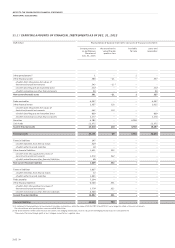 262
262 -
 263
263 -
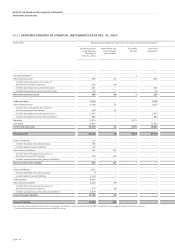 264
264 -
 265
265 -
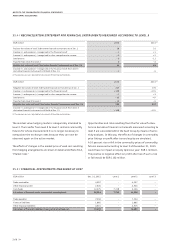 266
266 -
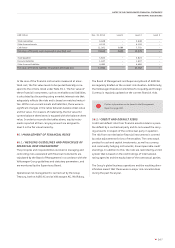 267
267 -
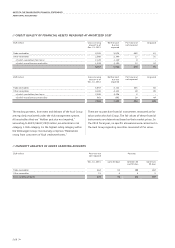 268
268 -
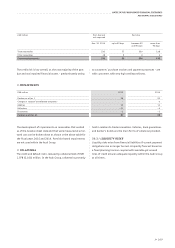 269
269 -
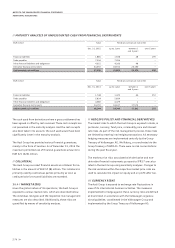 270
270 -
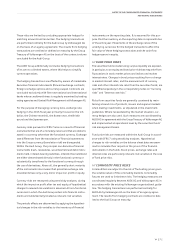 271
271 -
 272
272 -
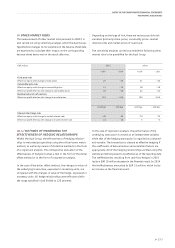 273
273 -
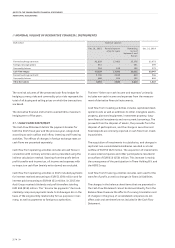 274
274 -
 275
275 -
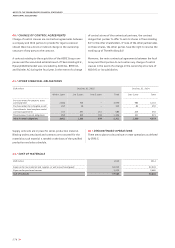 276
276 -
 277
277 -
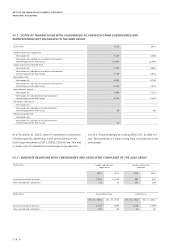 278
278 -
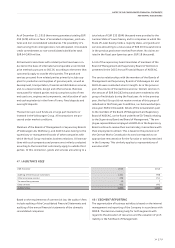 279
279 -
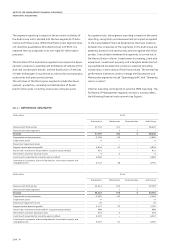 280
280 -
 281
281 -
 282
282 -
 283
283 -
 284
284 -
 285
285 -
 286
286 -
 287
287 -
 288
288 -
 289
289 -
 290
290 -
 291
291 -
 292
292 -
 293
293 -
 294
294 -
 295
295 -
 296
296 -
 297
297 -
 298
298 -
 299
299 -
 300
300
 |
 |

NOTES TO THE CONSOLIDATED FINANCIAL STATEMENTS
ADDITIONAL DISCLOSURES
272 >>
Hedging relates principally to significant quantities of the
commodities aluminum and copper. Contracts are concluded
exclusively with first-rate national and international banks
whose creditworthiness is regularly examined by leading rating
agencies and by Central Risk Management at Volkswagen AG.
Commodity price risks are also calculated using sensitivity
analyses. Hypothetical changes in listed prices are used to
quantify the impact of changes in value of the hedging trans-
actions on equity and on profit after income tax.
/// INTEREST RATE RISKS
Interest rate risks stem from changes in market rates, above
all for medium and long-term variable interest rate assets and
liabilities.
The Audi Group limits interest rate risks, particularly with
regard to the granting of loans and credit, by agreeing fixed
interest rates and also through interest rate hedging instru-
ments.
The risks associated with changing interest rates are presented
pursuant to IFRS 7 using sensitivity analyses. These involve
presenting the effects of hypothetical changes in market inter-
est rates as of the balance sheet date on interest payments,
interest income and expenses, and, where applicable, equity
and profit after tax.
/// RESIDUAL VALUE RISKS
Residual value risks arise from hedging arrangements with the
retail trade or partner companies according to which, in the
context of buy-back obligations resulting from concluded lease
agreements, effects on profit caused by market-related fluctu-
ations in residual values are partly borne by the Audi Group.
The hedging arrangements are based on residual value recom-
mendations, as published by the residual value committee at
the time of the contract being concluded, and on current dealer
purchase values on the market at the time of the residual value
hedging being settled. The residual value recommendations
are based on the forecasts provided by various independent
institutions using transaction prices.
Residual value risks are also calculated using sensitivity analyses.
Hypothetical changes in the market prices of used cars as of
the balance sheet date are used to quantify the impact on
profit after tax.
// QUANTIFYING MARKET RISKS BY MEANS OF
SENSITIVITY ANALYSES
/// CURRENCY RISKS
If the functional currencies had in each case increased or
decreased in value by 10 percent compared with the other
currencies as of the balance sheet date, the following major
effects on the hedging provision in equity and on profit after
tax would have resulted with regard to the currency relations
referred to below.
EUR million Dec. 31, 2015 Dec. 31, 2014
+10% – 10% +10% – 10%
EUR/CNY
Hedging reserve 320 – 320 381 – 381
Profit after tax – 31 31 – 48 48
EUR/GBP
Hedging reserve 831 – 831 526 – 526
Profit after tax 2 –2 –1 1
EUR/JPY
Hedging reserve 170 – 170 80 – 80
Profit after tax –3 3 –1 1
EUR/KRW
Hedging reserve 88 – 88 50 – 50
Profit after tax – 17 17 –9 9
EUR/USD
Hedging reserve 955 – 965 786 – 783
Profit after tax – 35 45 – 57 61
